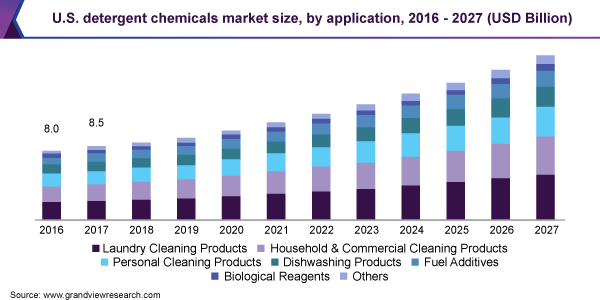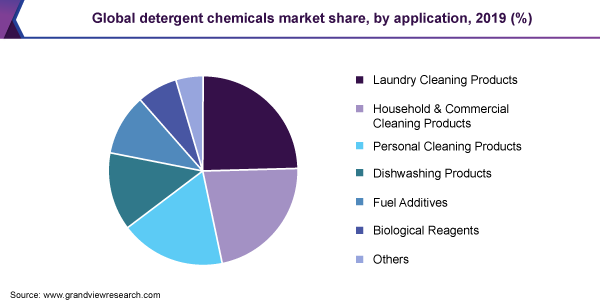
Detergent Chemicals Market Size, Share & Trends Analysis Report By Product (Surfactants, Builders, Enzymes, Bleaching Agents, Fragrances),By Application, By Region, And Segment Forecasts, 2020 - 2027
- Report ID: GVR-4-68038-730-8
- Number of Report Pages: 120
- Format: PDF
- Historical Range: 2016 - 2018
- Forecast Period: 2020 - 2027
- Industry: Bulk Chemicals
Report Overview
The global detergent chemicals market size was valued at USD 46.2 billion in 2019 and is expected to grow at a compound annual growth rate (CAGR) of 8.6% from 2020 to 2027. Increasing demand for detergents from cosmetics, personal care, institutional and household end use industries is expected to drive the market over the forecast period. Rapid urbanization and increased disposable incomes have enabled consumers to spend more on household laundry cleaning products. Furthermore, increasing literacy rate and rising awareness among consumers regarding personal and household hygiene have augmented the penetration of laundry detergents. These factors indirectly point toward the increasing consumption of detergent chemicals in the coming years.

The raw material feedstock for these detergent chemicals majorly comprises of petrochemicals or crude oil derivatives such as linear alpha-olefins, linear alkyl benzene, and ethylene oxide. Key players involved in the production and marketing of crude oil derivatives include Reliance Industries Limited, Royal Dutch Shell, and SABIC. However, the emergence of bioethanol based on agricultural waste material, sugarcane, or corn lately has shifted the market trend toward bio-based raw materials.
Detergent chemicals are either produced naturally from oleochemicals derived from plant oils or synthetically from petrochemicals. Major petrochemical feedstock includes benzene and ethylene, which are derived from crude oil, while major oleochemicals feedstock includes palm kernel oil and coconut oil. The difference in the use of feedstock creates a difference in the selling price of the final chemical produce.
Constantly evolving rules and regulations managing the chemicals used in the production of detergents chemicals pose a potential restraint to the market growth. In addition, the volatility in the prices and availability of feedstock pose a challenge for manufacturers who are trying to deliver the product uninterruptedly.
Product Insights
In terms of volume, surfactants dominated the market with a share of 31.8% in 2019. Surfactants are a diversified range of compounds that lower the surface tension between two interacting surfaces of liquid-solid, gas-liquid or liquid-liquid. Owing to this property, surfactants are widely utilized as detergents, wetting agents, dispersants, foaming agents, and emulsifiers.
The regulatory norms and regulations related to surfactants are strict and required to be followed at both the national and international levels. Surfactants used in-home care and personal care products are in direct consumer contact, therefore, the rules and regulations related to consumer safety are strict. Compliance with these rules along with the production of user-friendly chemicals is a significant industry challenge faced by global manufacturers.
Amylases, lipases, and proteases are some of the majorly used enzymes. Proteases are the commonly used enzymes in laundry detergents. Proteases help remove protein stains such as blood, grass, human sweat, and eggs. Amylases are generally used to remove deposits of starchy food products including spaghetti, mashed potatoes, custards, oatmeal porridge, chocolate, and gravies. These types of enzymes are used in chlorine-free dishwashing detergents as well as in laundry detergents. Lipases are mostly used to remove fatty stains including frying fats, salad oil, lipstick, butter and sauces, and tough stains on cuffs and collars.
Application Insights
In terms of volume, laundry cleaning products dominated the market with a share of 25.0% in 2019. This can be attributed to high product consumption in developing economies of Asia Pacific. Countries such as India and China are developing at flying rates and have become manufacturing hubs for most of the commodities, thus, showing positive growth prospects for laundry detergents as well. Detergent chemicals can be sourced naturally as well as synthetically. Few of the chemicals used in cosmetics formulation include linear alkylbenzene sulfonates, alcohol sulfate, and alcohol ethoxylates.
Household and commercial cleaning products such as floor cleaners and glass cleaners also generate substantial demand for detergent chemicals globally. Increasing awareness for cleanliness and hygiene has triggered segment growth in past and need for cleaning and sanitization in the midst of coronavirus outbreak is anticipated to fuel the growth of the segment in the coming years.

Apart from these, detergent chemicals also find application in personal cleaning, dishwashing products, fuel additives, and biological reagents. Personal cleaning products such as hand wash, shampoo, toothpaste, face wash also contain detergent chemicals to enhance their effectiveness. WHO’s guidelines on washing hands during the coronavirus outbreak is expected to boost the demand for hand wash liquids, which, in turn, will drive the detergent chemicals market.
Regional Insights
North America accounted for a volume share of over 25.9% in the market in 2019. Increasing consumption of detergent chemicals in applications such as personal care, industrial cleaners, and food processing is expected to drive the market over the forecast period. Furthermore, According to a Journal of the American Oil Chemists’ Society, North America accounts for a significant share in the production of soaps and detergents worldwide, which are major application areas of detergent chemicals. The market in the region is highly fragmented in nature owing to the strong foothold of key players in the region including Nouryon, Huntsman International LLC, and Croda International Plc.
Europe emerged as a prominent consumer of detergent chemicals in 2019. These chemicals are increasingly being used in personal care and cosmetics products formulations, which are expected to register high growth rates over the forecast period. Furthermore, the market for detergent chemicals in Europe is characterized by the presence of stringent regulatory policies framed by various agencies such as EEA, ECHA, and REACH favoring the consumption of detergent chemicals in the region.
Key Companies & Market Share Insights
The market is highly competitive with presence of well-established and long term operating players that acquire significant market share. The smaller players in the market may augment activities related to mergers, acquisitions, and strategic alliances to strengthen their foothold in the market. Major companies have a sturdy product portfolio with active involvement in several research and development activities. Certain companies in the market are adopting forward integrated approach with vendors producing large quantities of raw materials. The remaining raw materials are purchased from multiple suppliers. Vendors are engaged in developing new methods and alternate raw materials to derive detergent chemicals without phosphate owing to rising consumer awareness, growing environmental concerns, and the harmful effects of phosphate. Some of the prominent players in the detergent chemicals market include:
-
BASF SE
-
The Dow Chemical Company
-
Huntsman International LLC
-
Nouryon
-
Croda International plc
-
Solvay S.A.
-
Clariant AG
Detergent Chemicals Market Report Scope
|
Report Attribute |
Details |
|
Market size value in 2020 |
USD 50.5 billion |
|
Revenue forecast in 2027 |
USD 91.6 billion |
|
Growth rate |
CAGR of 8.6% from 2020 to 2027 |
|
Base year for estimation |
2019 |
|
Historical data |
2016 - 2018 |
|
Forecast period |
2020 - 2027 |
|
Quantitative units |
Volume in kilotons, revenue in USD billion, and CAGR from 2020 to 2027 |
|
Report coverage |
Revenue forecast, company share, competitive landscape, growth factors and trends |
|
Segments covered |
Product, application, region |
|
Regional scope |
North America; Europe; Asia Pacific; Central & South America; Middle East & Africa |
|
Country Scope |
U.S.; Canada; Mexico; Germany; U.K.; France; Italy; China; India; Japan; South Korea; Brazil; Argentina; South Africa; Saudi Arabia |
|
Key companies profiled |
BASF SE; Solvay; Huntsman Corporation LLC; Clariant AG; International Detergent Chemicals Ltd. |
|
Customization scope |
Free report customization (equivalent up to 8 analyst’s working days) with purchase. Addition or alteration to country, regional & segment scope |
|
Pricing and purchase options |
Avail customized purchase options to meet your exact research needs. Explore purchase options |
Segments Covered in the Report
This report forecasts revenue growth at global, regional, and country levels and provides an analysis of the latest industry trends in each of the sub-segments from 2016 to 2027. For the purpose of this study, Grand View Research has segmented the global detergent chemicals market report on the basis of product, application, and region:
-
Product Outlook (Volume, Kilotons; Revenue, USD Billion, 2016 - 2027)
-
Surfactants
-
Builders
-
Enzymes
-
Bleaching Agents
-
Fragrances
-
Others
-
-
Application Outlook (Volume, Kilotons; Revenue, USD Billion, 2016 - 2027)
-
Laundry Cleaning Products
-
Household & Commercial Cleaning Products
-
Personal Cleaning Products
-
Dishwashing Products
-
Fuel Additives
-
Biological Reagents
-
Others
-
-
Regional Outlook (Volume, Kilotons; Revenue, USD Billion, 2016- 2027)
-
North America
-
The U.S.
-
Canada
-
Mexico
-
-
Europe
-
Germany
-
The U.K.
-
France
-
Italy
-
-
Asia Pacific
-
China
-
India
-
Japan
-
South Korea
-
-
Central & South America
-
Brazil
-
Argentina
-
-
Middle East & Africa
-
South Africa
-
Saudi Arabia
-
-
Frequently Asked Questions About This Report
b. The global detergent chemicals market size was estimated at USD 46.2 billion in 2019 and is expected to reach USD 50.5 billion in 2020.
b. The global detergent chemicals market is expected to grow at a compound annual growth rate of 8.6% from 2020 to 2027 to reach USD 91.6 billion by 2027.
b. Surfactants dominated the detergent chemicals market with a share of 31.8% in 2019. This is attributable to their property that lowers the surface tension between two interacting surfaces of liquid-solid, gas-liquid, or liquid-liquid.
b. Some key players operating in the detergent chemicals market include BASF SE, Solvay S.A., Huntsman International LLC, Clariant AG, Croda International plc, and Nouryon.
b. Key factors that are driving the market growth include increasing demand for detergents from cosmetics, personal care, institutional, and households. Rising awareness among consumers regarding personal and household hygiene has augmented the penetration of laundry detergents.
We are committed towards customer satisfaction, and quality service.
"The quality of research they have done for us has been excellent."




